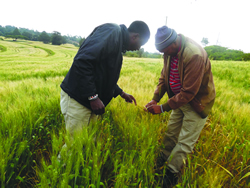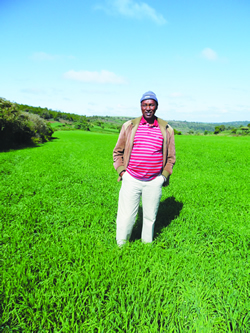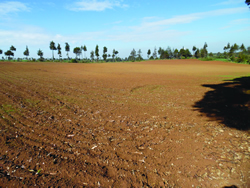Challenges Facing Barley Farming in Kenya

‘Although it does not tolerate highly humid warm climates, it is an adaptable cereal that has a growing range that extends from the sub-Arctic to upland areas of the subtropics. This suggests a gene pool of different varieties for wide environmental adaptability and good stress resistance’.
Conditions favouring barley farming in Kenya
Barley has good drought, cold, and salt tolerance and is generally produced in temperate and semiarid subtropical climates. Barley production occurs at higher latitudes and altitudes and closer to the limits of deserts than any other cereal crop, i.e. barley is generally produced under conditions of moderate water stress. Ideal growth conditions are well-drained loam soils, at moderate rainfall (400 – 800 mm) or under irrigation, and at moderate temperature regimes (15 – 30 ° C) (Jaetzold, 2006a, Ullrich, 2011). Environmental abiotic stress factors that can cause severe grain losses are often caused by high or low temperatures, drought, anaerobiosis (i.e. the absence of oxygen in the soil), and soil anomalies such as excess salt. Such abiotic stresses often occur simultaneously, for example, drought (i.e. water availability below that required for maximum crop yield) is often associated with the occurrence of high temperatures. Soil salinity and soil sodicity are common problems in arid and semiarid areas, therefore barley varieties grown in these marginal areas have to be tolerant to soil salinity (Cattivelli et al., 2011). Although barley tends to be better suited to higher altitudes, there is a fine balance between suitability and productivity. Rain tends to start earlier at higher altitudes, but growing periods lengthen at higher altitudes because the production of biomass is slower in cooler altitudinal climates. Therefore, the chances of a crop ripening before the end of the rainy season becomes smaller in the higher belts (Jaetzold, 2005). This balance is affected when climate change causes temperature rises along the altitudinal belts.

Barley germination time is one to three days and grows under cool conditions. It is more tolerant of soil salinity than wheat, and has a short growing season and is also relatively drought tolerant. The most common malting barley varieties used in Kenya are Fanaka, Cocktail, Quench, Sabini and Nguzo.
Although the latter two are currently being phased out as they are older varieties with lower yields, it is recommended that seed samples be preserved in the interest of retaining this element of species biodiversity. Cocktail and Quench perform well at high altitude areas with a longer growth period, while the other varieties can be grown in different regions if the timing of planting is done well. The potential yield for many of these varieties is as high as 6 t/ha, but currently, in Kenya, average yield is approximately 2 t/ha.
The barley growing season depends on the onset of rainfall, with the main rainfall season stretching from February to October. Ninety percent of barley is planted after the first rains of the season, with a small amount of barley in Timau planted “dry”. Most barley production areas in Kenya have a mid and late planting season, with only Timau and Kinangop having two planting seasons due to the availability of rainfall.
Disease Management.
Powdery mildew: Powdery mildew is often present in susceptible varieties, but generally causes only relatively small yield loss. Control: - seed and fertilizer treatments can give good early season control of powdery mildew and use of resistant barley varieties.
Leaf rust and stem rust: Leaf rust and stem rust are the major air-borne diseases of barley. They are more likely to occur in wetter seasons or in higher rainfall areas. Both can cause significant yield loss and quality downgrading.
Control: - Planting resistant varieties and avoidance of very early or very late plantings are the best protection against rusts
Head blight: Head blight in barley may be caused by several species of fungus. Damage can range from death of single florets to loss of the whole head. The fungi responsible are stubble borne and infection is favoured by extended wet conditions at and shortly after head emergence.

- Select a suitable variety. Leaf rust, net blotches and powdery mildew are the more important diseases for which selection of resistant varieties can improve performance and reliability.
- Treat seed with appropriate fungicidal dressing as smuts and net blotch may be seed borne.
- Plant in good soil moisture and with the correct plant population.
- Use adequate nitrogen fertilizer but do not over fertilize as this will encourage excessive vegetative growth and could result in lodging.
- Carry out crop rotations and soil test to have adequate nutrition.
- Inspect crop regularly for insect infestations and foliar diseases and use appropriate control methods.
Harvesting and post harvest handling
Barley has matured when it’s golden in color and brittle. If the barley is for malting purpose (for beer, other alcohol and malted foods), or it involves mass production advanced tools are to be used. For human food, cut the barley plants manually.
Harvesting is generally done by combine harvester. Harvesting time of barley depends on the time of sowing, cropping period and maturity. Barley is more prone to shattering. So, in order to reduce this type of loss, barley crop should be harvested before being fully matured and in the morning hours.
The challenges
Lack of credit facility to get inputs and finance other farm operations is the biggest challenge. In addition market prices coupled with tough conditions to be met especially with standard quality i.e. Nitrogen levels. Unreliable rainfall remains another challenge to barley production, specifically drought after germination and excessive rainfall during harvesting.
Sorghum impact to barley farmers
As barley crops dwindle and production of drought-tolerant sorghum increases. This means farmers will opt to go for Sorghum in place of barley hence reduce area under barley production.
As part of the project, farmers may be instructed in sustainable sorghum production, given access to seeds of improved sorghum varieties, and helped in establishing links to markets. Most of the farmers are selling their sorghum locally to East Africa Breweries, but they are ready for the prospect of markets opening further afield.
Expected government support
The government should offer support in terms of financing, machinery, subsidize fertilizer and seeds for barley farmers. These will encourage farmers to do it as a business where they are assured of return on investment, provide employment to youths and improve our exports which in turn improves our foreign exchange.
There is potential to compensate for loss of land suitability through increased yields per unit area (plant breeding and improved cultivation methods), in the coming years, although historically, yields across Kenya have shown no increase over time.